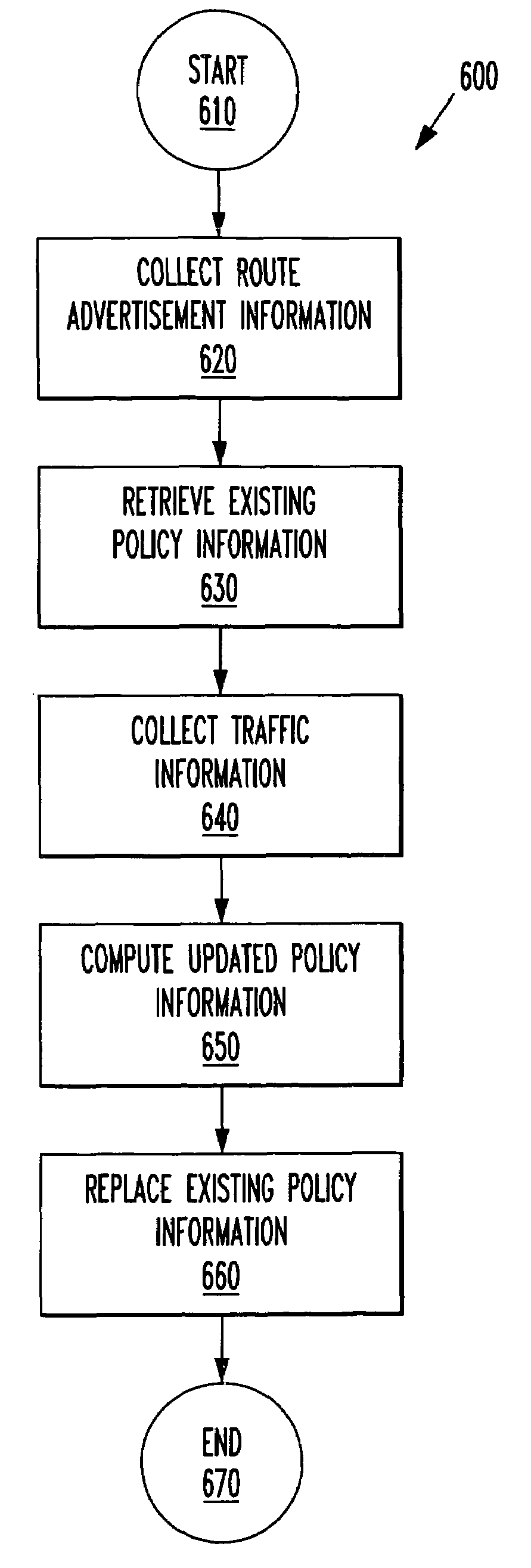System and method for optimally configuring border gateway selection for transit traffic flows in a computer network
- Summary
- Abstract
- Description
- Claims
- Application Information
AI Technical Summary
Benefits of technology
Problems solved by technology
Method used
Image
Examples
example 1
[0058]Consider the AS illustration in FIG. 1A having four border routers b1,K,b4. Routers b1 and b2 serve as ingress routers (so K1=K2=0) with capacity constraints C1=50 and C2=60, respectively. Routers b3 and b4 are egress routers (so C1=C2=0) with bandwidth constraints K3=75 and K4=50, respectively. The intra-domain distances between ingress and egress routers are as shown in FIG. 1A. Thus, d(1,3)=10 and d(1,4)=50. Two prefixes P1 and P2 are advertised at both egress routers, and so Out(1)=Out(2)={3,4}. Two AS neighbors A1 and A2 ingress data traffic through the ingress routers, so In(1)=In(2)={1,2}Finally, the amount of traffic from the AS neighbors to the destination prefixes is given by t(1,1)=t(2,2)=30,t(1,2)=15 and t(2,1)=25.
[0059]FIG. 1B depicts the optimal assignment δs for the single egress case. In the assignment, δs(1,1)=(1,3), δs(1,2)=(1,4), δs(2,1)=(2,3) and δs(2,2)=(2,4). Router b1 ingresses all the traffic from A1, while b2 ingresses all traffic from A2. Also, b3 egr...
example 2
[0077]Revisiting Example 1, consider the AS in FIG. 1. Suppose that egress router b3 is selected to egress traffic for prefix P1 and egress router b4 is chosen to egress traffic for P2. Then, the problem of computing the optimal ingress routers for traffic from ASes A1 and A2 to prefixes P1 and P2 is equivalent to GAP. In the GAP instance, there are two machines 1 and 2 corresponding to ingress routers b1 and b2 with processing times T1=C1=50 and T2=C2=60. Further, there are four jobs corresponding to (Ah,Pk) pairs (1,1), (1,2), (2,1) and (2,2). The processing time of job (1,1) on both machines is t(1,1)=30, while the processing time of job (1,2) is t(1,2)=15. The cost of processing job (1,1) on machine 2 is d(2,3)·t(1,1)=600 (since b3 is egress router for P1), while that of processing job (1,2) on machine 1 is d(1,4)·t(1,2)=750 (since b4 is egress router for P2) Clearly, the optimal assignment for the GAP instance is also the optimal cost assignment for the SES instance with egress...
PUM
 Login to View More
Login to View More Abstract
Description
Claims
Application Information
 Login to View More
Login to View More - R&D
- Intellectual Property
- Life Sciences
- Materials
- Tech Scout
- Unparalleled Data Quality
- Higher Quality Content
- 60% Fewer Hallucinations
Browse by: Latest US Patents, China's latest patents, Technical Efficacy Thesaurus, Application Domain, Technology Topic, Popular Technical Reports.
© 2025 PatSnap. All rights reserved.Legal|Privacy policy|Modern Slavery Act Transparency Statement|Sitemap|About US| Contact US: help@patsnap.com



